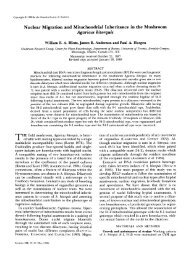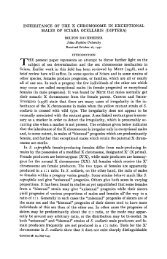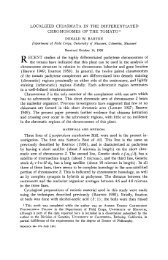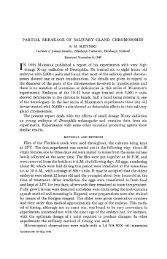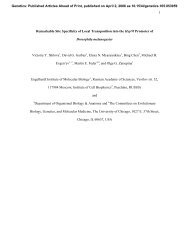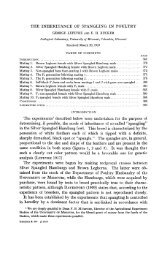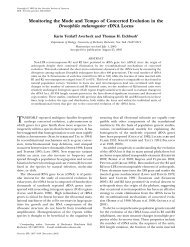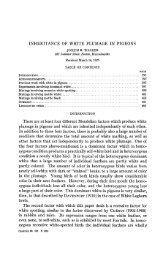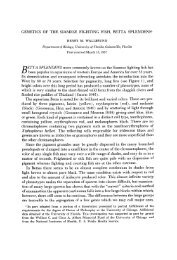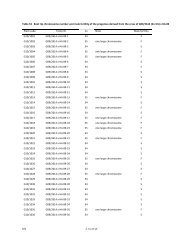abstracts of papers presented at the 1962 meetings - Genetics
abstracts of papers presented at the 1962 meetings - Genetics
abstracts of papers presented at the 1962 meetings - Genetics
You also want an ePaper? Increase the reach of your titles
YUMPU automatically turns print PDFs into web optimized ePapers that Google loves.
ABSTRACTS 997<br />
indole requirement simultaneously with acquisition <strong>of</strong> a histidine requirement (EPHRATI-ELIZUR,<br />
SRINNASAN and ZAMENHOF, Proc. N<strong>at</strong>l. Acad. Sci. U.S. 47:56, 1961). A similar phenomenon<br />
was found in Serr<strong>at</strong>ia (KAPLAN, 2. Vererb. 92:21, 1961).-In <strong>the</strong> present study, DNA’s from<br />
two such strains (12 and 21) were used to transform <strong>the</strong> parent histidine+ indole- (nonlinked)<br />
strain. In both cases <strong>the</strong> transform<strong>at</strong>ion to indole+ was accomplished, and with usual yield; this<br />
suggests th<strong>at</strong> in strains 12 and 21 <strong>the</strong> mut<strong>at</strong>ion to histidine- by itself did not suppress indole-,<br />
but was “coupled” with ano<strong>the</strong>r mut<strong>at</strong>ion, which ei<strong>the</strong>r produced true repair <strong>of</strong> indole-, or else<br />
an unrel<strong>at</strong>ed suppressor <strong>of</strong> indolc. The n<strong>at</strong>ure <strong>of</strong> this coupling is not clear; it suggests th<strong>at</strong><br />
various “nonlinked” segments <strong>of</strong> DNA miolecule may not be mut<strong>at</strong>ionally independent.<br />
No reversions to indole+ were observed among IO5 survivors <strong>of</strong> he<strong>at</strong>ing th<strong>at</strong> did not mut<strong>at</strong>e to<br />
histidine-, indic<strong>at</strong>ing th<strong>at</strong> <strong>the</strong> phenomenon is not due to <strong>the</strong> accidental coincidence <strong>of</strong> two independent<br />
mut<strong>at</strong>ions.<br />
ZIMMERING, S., Indiana University, Bloomington, Ind.: Temper<strong>at</strong>ure effects and segreg<strong>at</strong>ion<br />
in Drosophila mazes.-The sc4-sc8 chromosome lacks most <strong>of</strong> <strong>the</strong> proximal heterochrom<strong>at</strong>in including<br />
pairing sites (“collochores” <strong>of</strong> COOPER) and leads to an appreciable frequency <strong>of</strong> nullo-Xnullo-Y,<br />
and a higher than normal frequency <strong>of</strong> XY, gametes from males carrying this X chromosome<br />
and a Y chromosome (GERSHENSON 1940; SANDLER and BRAVER 1954). When males <strong>of</strong><br />
<strong>the</strong> composition ysc4-sc*/sc8-Y are raised <strong>at</strong> 26°C and 18°C from egg to eclosion, and <strong>the</strong>n tested<br />
<strong>at</strong> 26”C, <strong>the</strong> rel<strong>at</strong>ive frequencies <strong>of</strong> <strong>the</strong> four kinds <strong>of</strong> gametes produced (from large scale experiments)<br />
are, for those raised <strong>at</strong> 26”C, Xz48.2; Yz21.4; XYz2.0; 0=28.5, and for those raised<br />
<strong>at</strong> 18”C, X=48.3; Y=42.2; XY=3.5; 0=6.0. The question arises: is <strong>the</strong> more normal transmission<br />
<strong>of</strong> <strong>the</strong> Y chromosome from <strong>the</strong> experiments <strong>at</strong> <strong>the</strong> cooler temper<strong>at</strong>ure simply <strong>the</strong> result<br />
<strong>of</strong> a gre<strong>at</strong>er opportunity for <strong>the</strong> Y chromosome to pair with and disjoin from <strong>the</strong> X chromosome<br />
or is its more regular behavior independent <strong>of</strong> pairing. Th<strong>at</strong> <strong>the</strong> l<strong>at</strong>ter interpret<strong>at</strong>ion may be<br />
correct is suggested by <strong>the</strong> finding th<strong>at</strong> from Bar-Stone males <strong>of</strong> <strong>the</strong> composition XD,XPYL.YS<br />
and not carrying a free Y chromosome, <strong>the</strong> component XPYL.YS, which is present as a univalent,<br />
is recovered with virtually normal frequency when such males are raised <strong>at</strong> 18°C (and tested<br />
<strong>at</strong> 26°C) despite an approxim<strong>at</strong>e 5045% loss <strong>of</strong> this component when <strong>the</strong>y are raised <strong>at</strong> 26°C.<br />
The possibility th<strong>at</strong> <strong>the</strong> l<strong>at</strong>ter results are rel<strong>at</strong>ed to <strong>the</strong> so-called A effect (ZIMMERING 1960;<br />
ZIMMERING and BARBOUR 1961) has been ruled out experimentally. (Supported by N.S,.F. grant<br />
G13568.)





